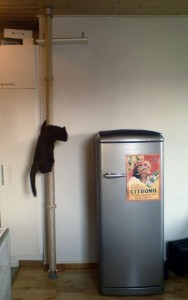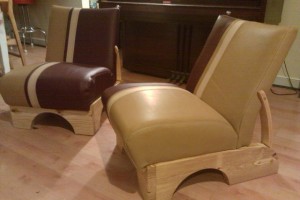May 18th, 2011 — Furniture, Uncategorized

Materials: STOLMEN post + mounting fixtures, sisal rope, small shelf, HESSUM doormat Description: Because cat furniture is the ugliest around and my friend needed every inch of her small apartment, I came up with this minimalistic climbing post . The shelf was on the wall already. The parts I needed cost about 60 euros. Steps: 1) I had to buy the 40 meters of rope in four 10 meter pieces.
Visit link:
Minimalistic floor-to-ceiling climbing post for cats
January 19th, 2011 — Furniture, Uncategorized

Materials: Lack Side Table, Idealisk Measuring Cup Description: What happens when you’re fed up with the cheap quality, high priced, children furniture sold in stores??? You say screw it and make your own cheap quality furniture for less. This hack came about when I tried to purchase a chalk table for my preschool art classes. As I later discovered that these chalkboard tables can go for an obscene amount of money, I figured, “I can build it for less than $50.” I was DEAD WRONG because it only cost me less than $25 in materials
Read more from the original source:
For LACK Of A Reasonably Priced Chalk Table
July 11th, 2010 — Furniture, Modern Furniture
Materials: Skala Tray
Description: I liked the design of the tray, but I thought it was a little boring and I didn’t think the finish was very durable. I often eat at the coffee table especially when Glenn is gone so I thought a tray would be useful for carrying my dinner and glass of wine.
We have an entire drawer full of travel brochures, maps, tickets stubs and all sorts of Japanese memorabilia since we’ve lived here for 18 months. I thought it would be fun to use all of this to dress up the plain tray.
I used Modge Podge to glue down the paper scraps and then 5 coats of the Podge on top. Waiting for it to dry between each layer. I had high gloss Modge Podge so it has a glossy finish. I hope we have it for a long time and it reminds us of our time here.
to glue down the paper scraps and then 5 coats of the Podge on top. Waiting for it to dry between each layer. I had high gloss Modge Podge so it has a glossy finish. I hope we have it for a long time and it reminds us of our time here.
See more of Kelly’s Japanese Skala tray.
~ Kelly, NAF Atsugi, Japan



July 11th, 2010 — Furniture, Modern Furniture
Materials: 1 $1.99 Ikea wood cutting board, 8 galvanized 1 1/2″ Grabber screws, table saw, drill and countersink, drill/driver, wood putty, Workmate 400 workbench , carpenter’s wood glue
, carpenter’s wood glue
Description: I’ve been using our bread machine a lot recently, and wanted a miter box to help me cut thinner, more consistent slices. The $1.99 Ikea cutting board I’d been using for a couple of years was warping, so was fair game for cutting up to make such a device.
a lot recently, and wanted a miter box to help me cut thinner, more consistent slices. The $1.99 Ikea cutting board I’d been using for a couple of years was warping, so was fair game for cutting up to make such a device.
Using the remnant of the last loaf I had baked as a template, I took measurements and laid out cut lines on the soon-to-be-ex-cutting board. I designed it so the front panel extends down a half inch below the front lip of the countertop – the so-called bench hook effect, so the whole contraption doesn’t slip around while you are sawing your rustic loaf.
A miter box could hardly be simpler, consisting as it does of only three pieces – front, back, and bottom. This box, designed around the loaf that comes out of a Breadman bread machine, wastes only a 3/4 -inch crosswise strip from the Ikea cutting board.
I held the bottom panel vertically in the Workmate vise, and aligned the front panel horizontally on top of it, countersinking one hole at a time, then fastening them temporarily with a screw.
The reason to drill and fasten one screw at a time is because the bottom panel had a curve in it, due to the previous warping of the cutting board, and I was able to straighten it out by bending it straight with my hands until the screws could take the tension. When all the screws were fitted, I disassembled it, applied glue to the two joints, and reassembled it.
I marked vertical cut lines on the front and back panels and cut the slots with a large hand saw. In retrospect, this is not really accurate enough, and next time I’ll do this job on the table saw while the parts are disassembled. Since I’m right-handed, the cut slot is near the right side of the box.
I filled the screw holes with wood putty, waited for it to dry, and sanded the plugs flush. Then I sanded off all the various pencil marks and knocked down the fresh cut edges a little to avoid sliver hazards. Finally, I applied Ikea Skydd, food-grade mineral oil for conditioning cutting boards.
~ Mark Ungar, Richmond, CA



February 8th, 2010 — Furniture, Uncategorized

Tim gives a new mid-century twist to these side chairs. “I’m not sure what the Ikea name for these side chairs is, but they were old and wobbly and the back legs were breaking off.
Read more:
Side chairs into mid-century-ish club chairs








